This vanilla bean cake is super moist, full of vanilla flavor, is rich and buttery, made from scratch and covered in buttercream. It’s the best vanilla cake I’ve ever had and I have a feeling it will quickly become your family’s favorite.
When it comes to cake, there is nothing more comforting than a vanilla cake. It’s a classic for a reason. It’s not overpowering in flavor and is perfect for weddings and birthdays.
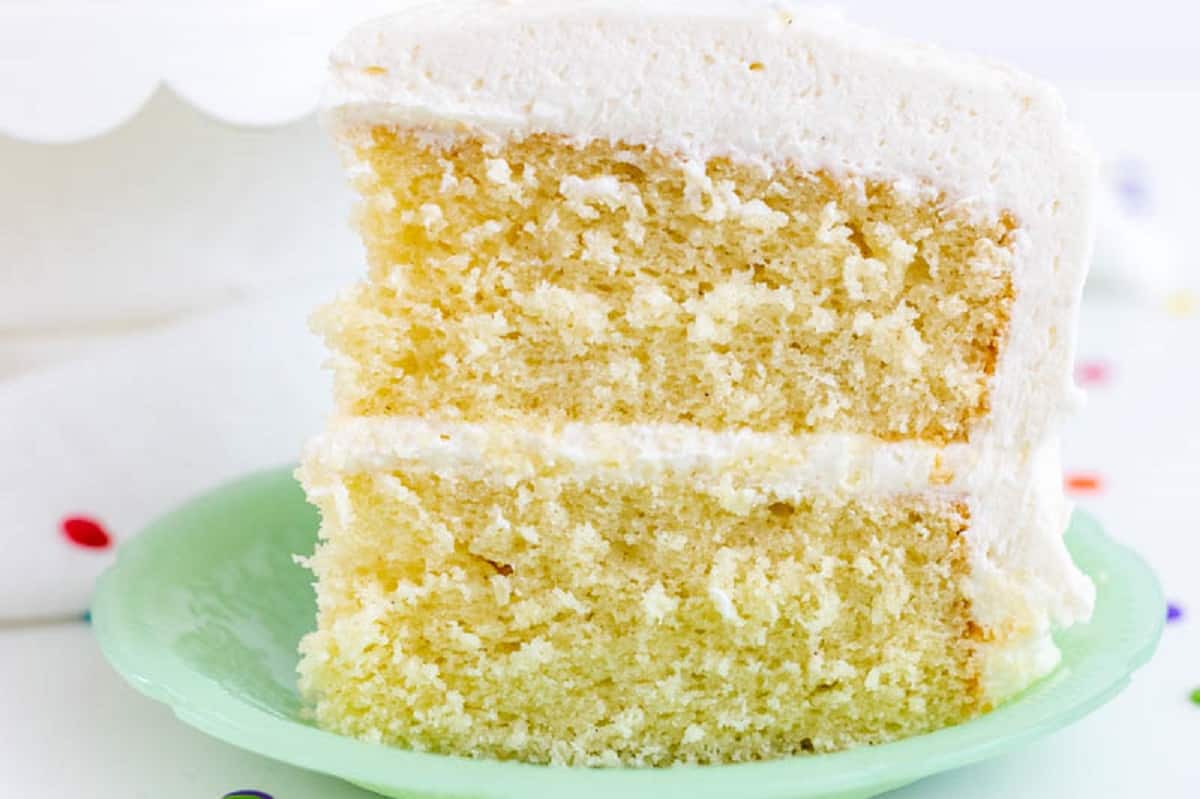
Hey there! Before you scroll, there’s lot’s of important stuff in the post!…including the FAQ section, which may answer any questions you might have about this recipe. Enjoy!
The good news is that you don’t need a box mix to make a good vanilla cake. This cake is super moist, with just the right amount of sweetness without being too heavy or dense like some scratch cakes can be.
Plus it’s actually pretty easy to make. In my opinion, it’s the absolute best vanilla cake recipe and you won’t want to stop eating it.
I’ve also included a video lower in the post on how to make this layer cake from scratch so that you can follow along step-by-step.
Ingredient Notes:
Now let’s talk a little about just some of the ingredients that are in this vanilla bean cake. (The printable list of all ingredients are in the recipe card below.)
(Make sure to check out the FAQ section below in this post for substitution questions.)
Cake flour: This recipe calls for cake flour instead of all-purpose flour. Using cake flour will give your cake a softer texture. If you can’t get cake flour, make sure to check out the FAQ section lower in this post for a substitute.
Unsalted butter: Butter gives this cake a really nice flavor. It also gives a lot of moisture to the cake.
Sour cream: I love using sour cream in cakes. It really adds to the flavor and gives it a ton of moisture.
Vanilla bean paste: This is the real flavor star of this recipe. Although you can still use vanilla extract, using vanilla bean paste gives it even more flavor. It’s just so good and I urge you to just try it.
Here are a couple of vanilla bean pastes to try:
Sometimes, vanilla pean paste can get a little expensive though, so just know that you can use vanilla extract and it’ll still taste amazing.
Almond baking emulsion: This ingredient is optional, but I think it’s really the secret ingredient to this cake.
Now, just hear me out on the almond emulsion. The recipe only calls for a very small amount and it does NOT taste like ordinary almond extract, which I personally don’t even like.
No, this recipe calls for almond baking emulsion, not almond extract. To me, they taste WAY different.
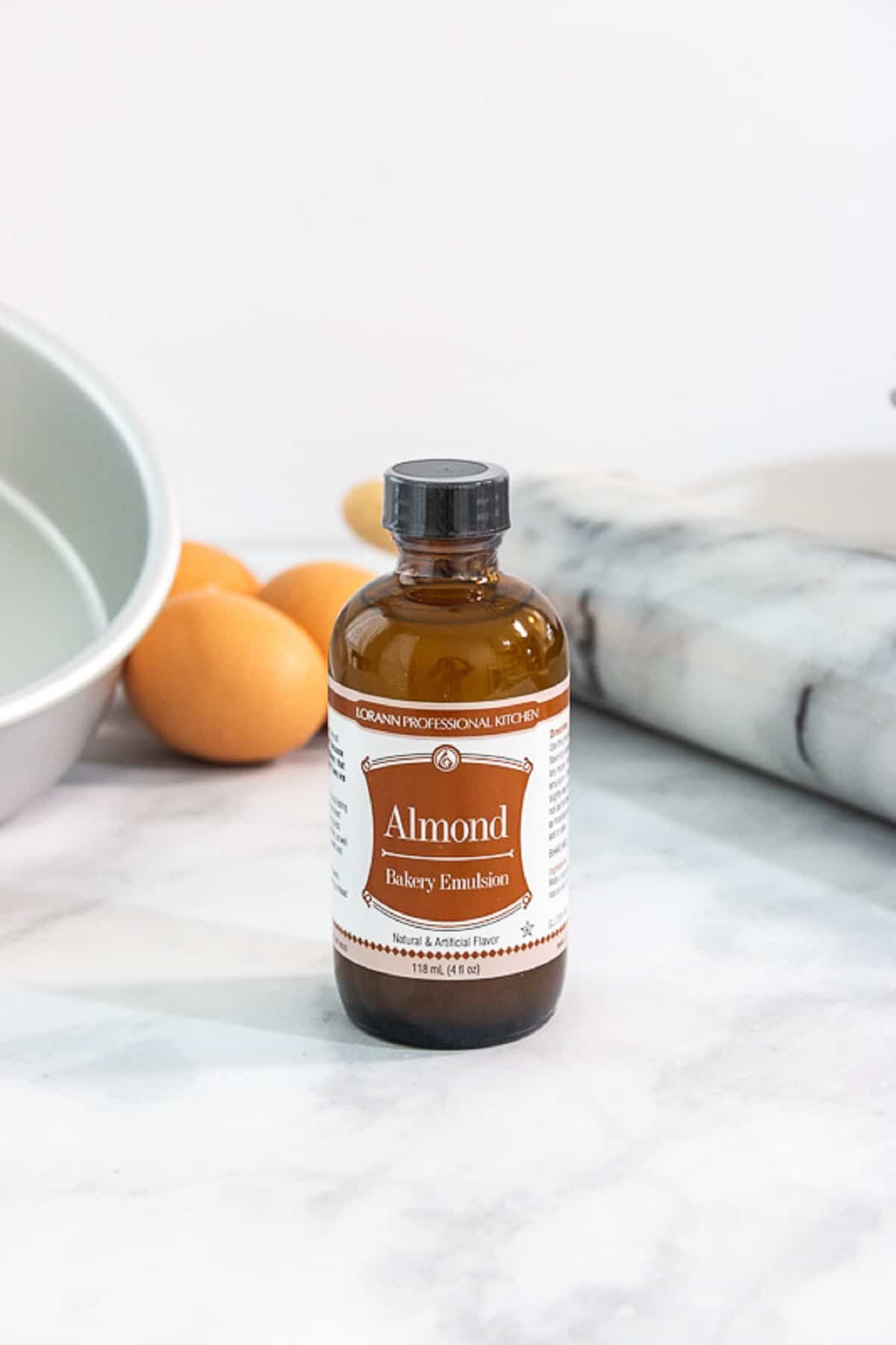
Even if you think you won’t like anything with almond extract in it…I have one question for you…have you tried it? Sometimes things taste totally different than you expect. I mean I don’t even like almonds, but I like this because to me…it doesn’t taste like almonds.
Here’s my point on the almond emulsion: This recipe only calls for half a teaspoon. That isn’t much and it’s not strong or overpowering at all. All it does is help bring out the flavor of the vanilla bean paste.
When you taste this cake, you don’t really taste an almond flavor. You just know it’s got this full vanilla bean flavor and something a little special that makes you never want to stop eating it.
I’ve personally been told loads of times by people that they don’t what’s in the cake, but they just couldn’t stop eating it.
As always though…if you are allergic to almonds, then don’t use it. If you’ve already tried it and you don’t like it…it’s ok! I won’t be mad at you and you can still make this cake with just vanilla bean paste or extract and it will STILL be awesome.
Vanilla bean buttercream: You’re gonna want to add buttercream to this cake and I have just the one for you. You can find that recipe here: Vanilla Bean Buttercream
How to Make this Cake:
Let’s talk a little about how to make this vanilla bean cake. (The printable instructions are in the recipe card below.)
Step 1:
First, you’ll need to preheat the oven to 350 degrees F. (Now, just know that you’re going to turn the oven temp down to 325 degrees F once you put the cakes in the oven.)
The thought process behind this is to give the cake a boost of heat to help it rise higher, but then to let the temp go lower so that it doesn’t over-brown the bottom and top.
You’ll also want to go ahead and grease and flour two 8-inch round cake pans that are about 2 inches high. (If making cupcakes, make sure and read the notes in the recipe post or the FAQ section lower in this post.)
Step 2:
Now combine the flour, sugar, baking powder, baking soda and salt in a mixing bowl and whisk.
Step 3:
In another bowl, combine the sour cream, milk, oil, vanilla, almond and eggs. Mix well with a whisk and set aside.
Step 4:
Now cut the butter into chunks. Then, turn the mixer on low and add the butter slowly to your dry ingredients. You’ll just mix on low to medium until all the butter is added, then switch to medium, medium-high and mix until all the flour is coated with the butter and the mixture is crumbly.
You want the mixture to resemble a sand-like texture.
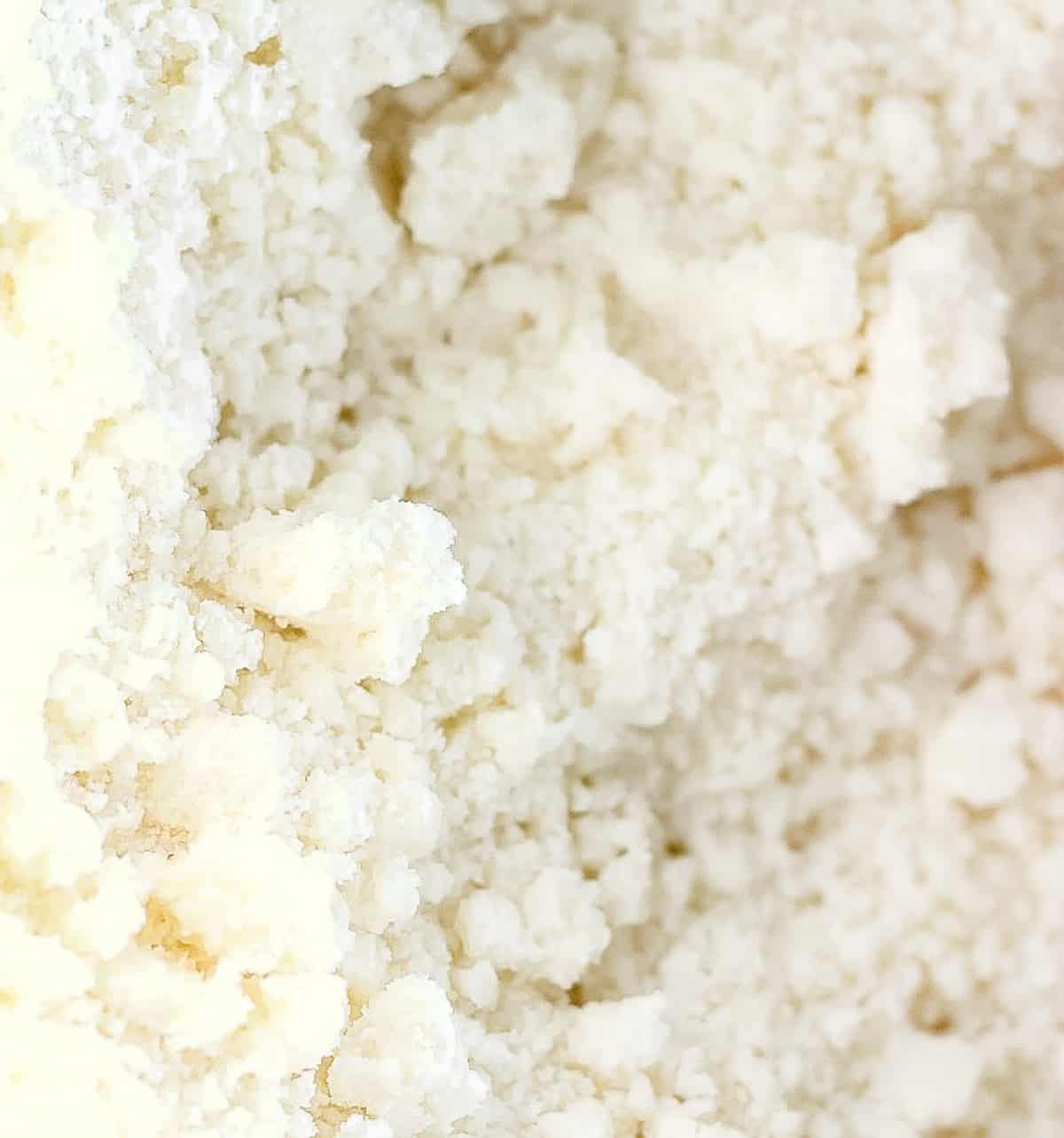
Step 5:
Now pour in about a third of the liquid mixture. Mix that in on low to medium until combined…about 30 seconds to one minute. (Some reverse creaming recipes call for mixing 1-2 minutes at this stage, but be careful about mixing longer than a minute as mixing for too long will cause a dense, rubbery cake.)
Pour the last of the liquid mixture and mix again until well combined. Don’t overmix the batter at this point. Stop mixing once everything is well incorporated.
Use a rubber spatula and scrape the sides of the bowl. Mix again for only about 10 to 15 seconds though.
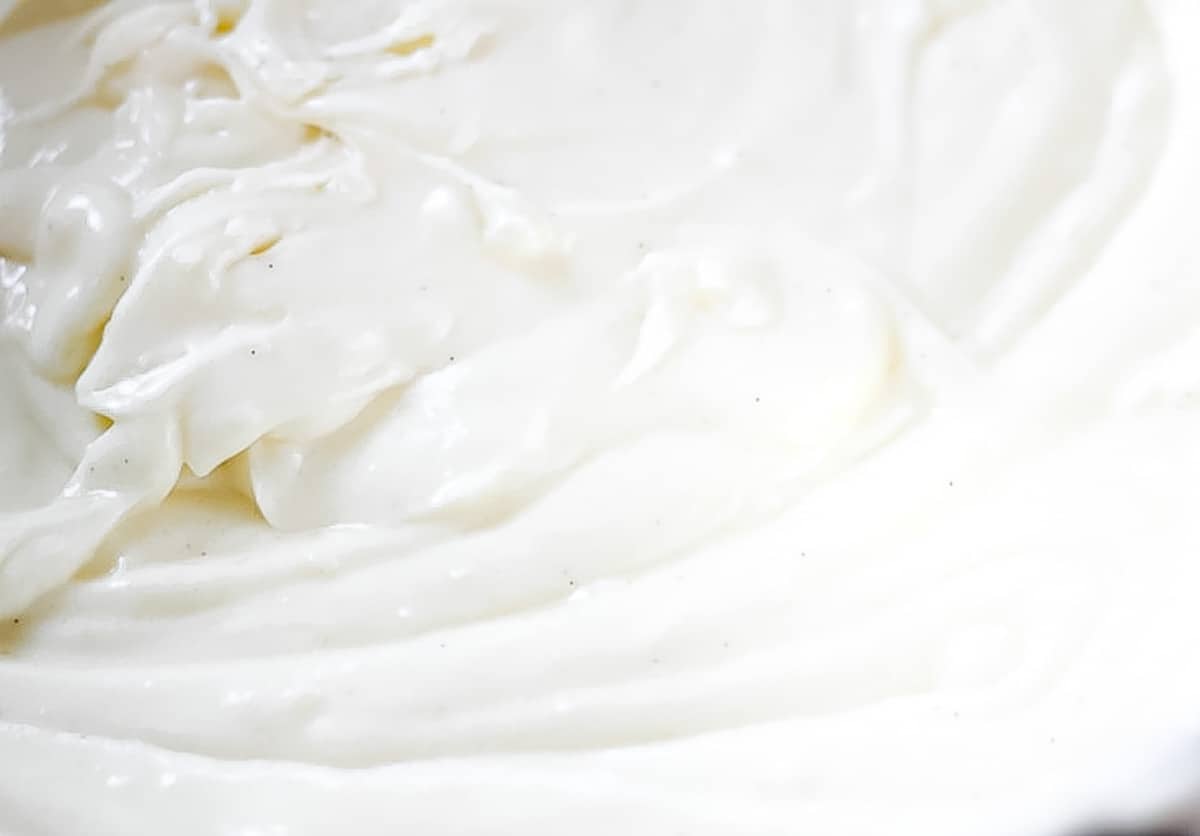
Step 6:
Pour the cake batter into the prepared pans.
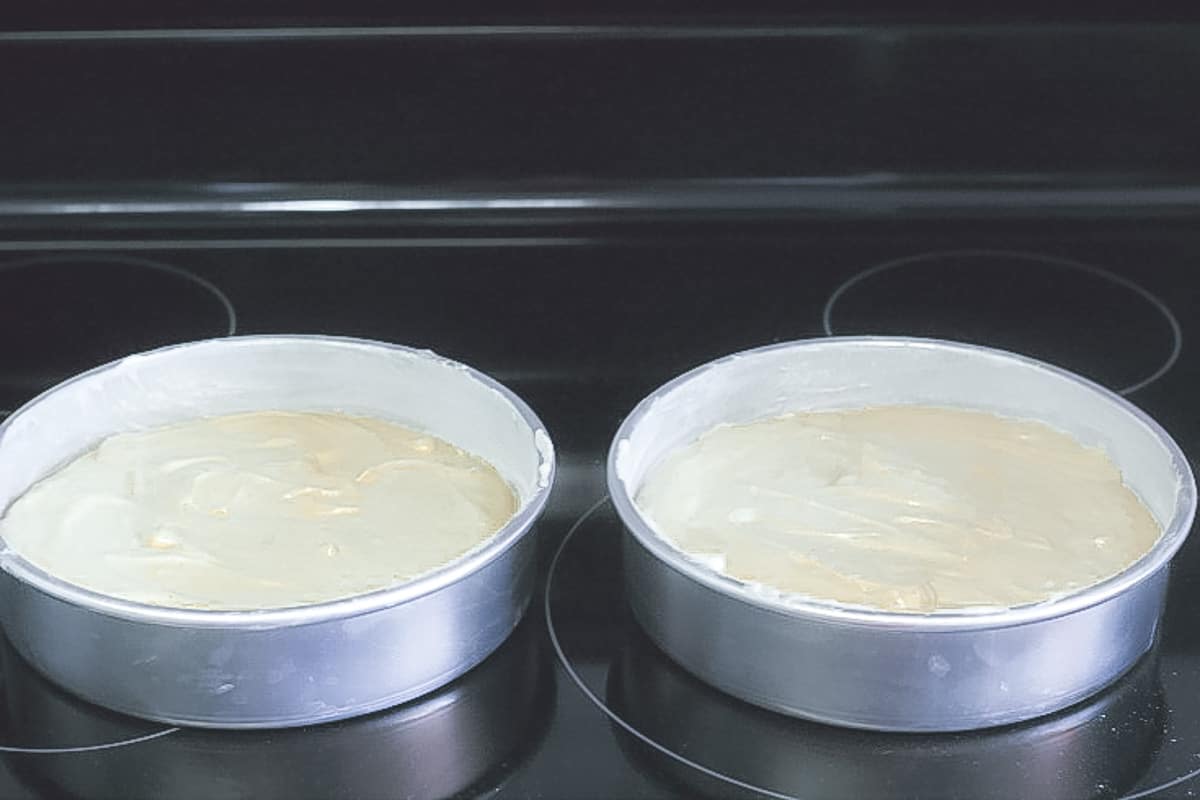
Slide the cakes into the oven and make sure to turn the temperature down to 325 degrees F (unless you’re making these as cupcakes, in which case you’ll want to read the notes below).
Bake the cake layers at 325 degrees F for approximately 40-45 minutes.
The cakes are done when a toothpick inserted into the center of each cake layer comes out with either a few moist crumbs on it or clean, but now raw batter.
You don’t have to wait until the toothpick comes out clean. Just make sure it doesn’t have raw batter on it.
Step 7:
Set the cake layers on wire racks and let them cool for about ten minutes. After they’ve settled for ten minutes, turn the cakes out of the pans and onto the racks.
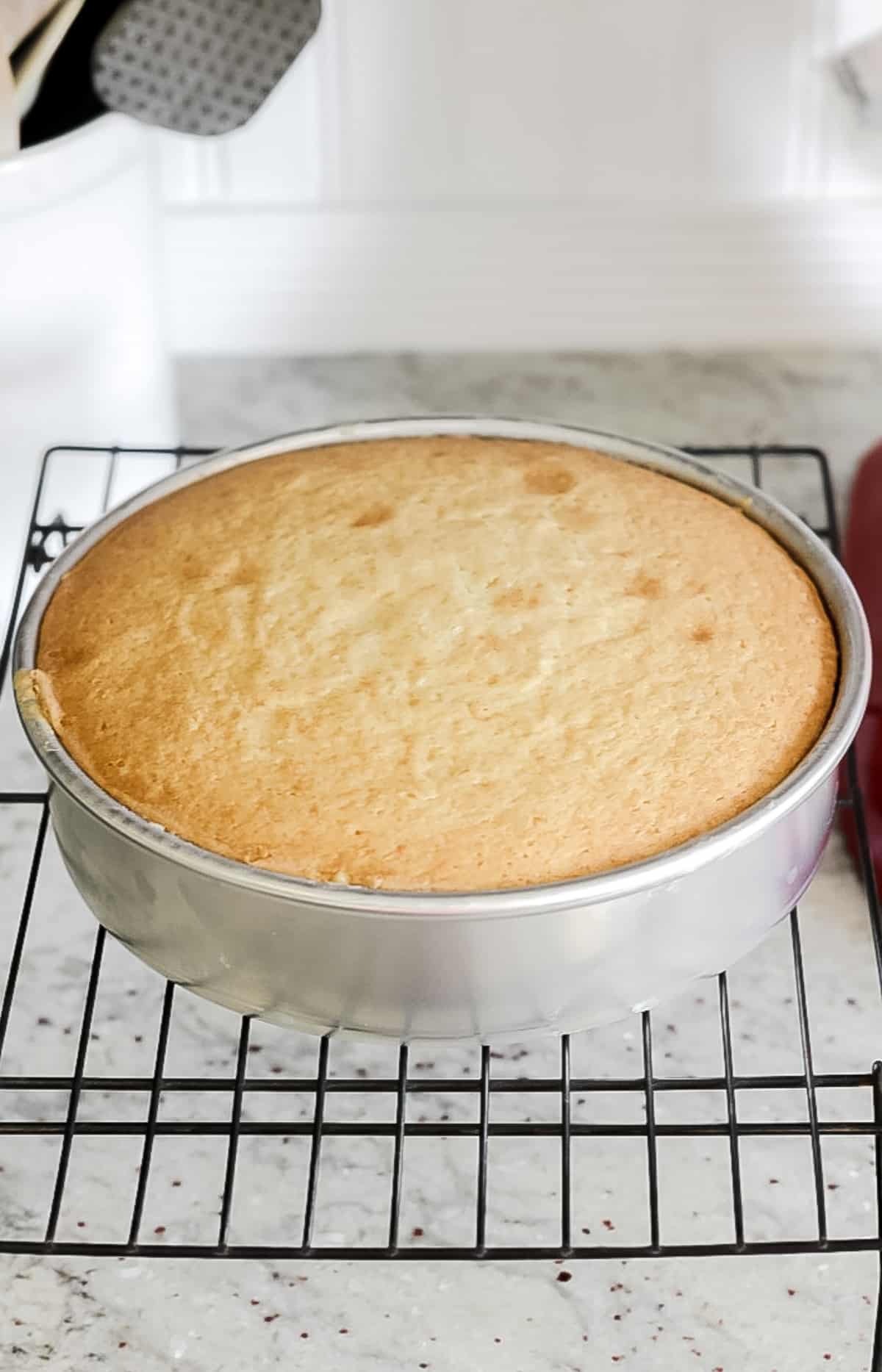
Let them cool out of the pans completely before adding buttercream frosting or freezing the layers.
See my post on how to freeze cake layers and cupcakes here: How to Freeze Cake & Cupcakes
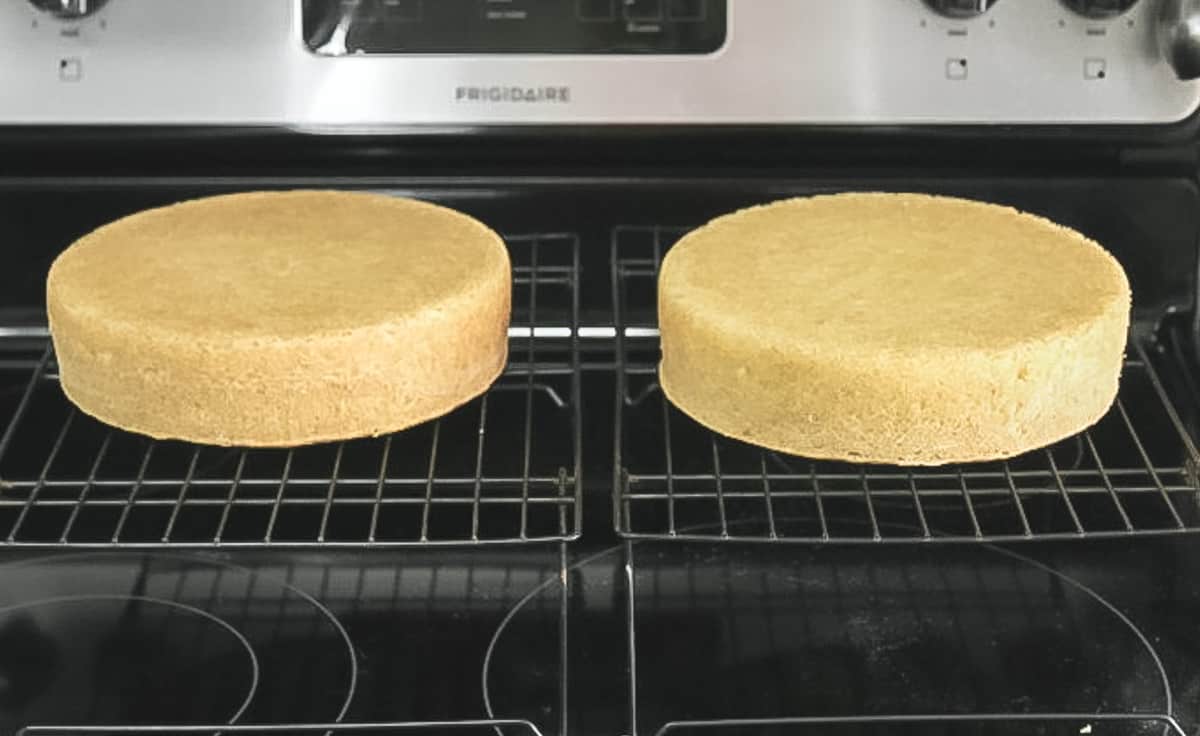
Step 8:
Once the layers are cooled, set one layer on a cake plate or cake platter and add buttercream to the top.
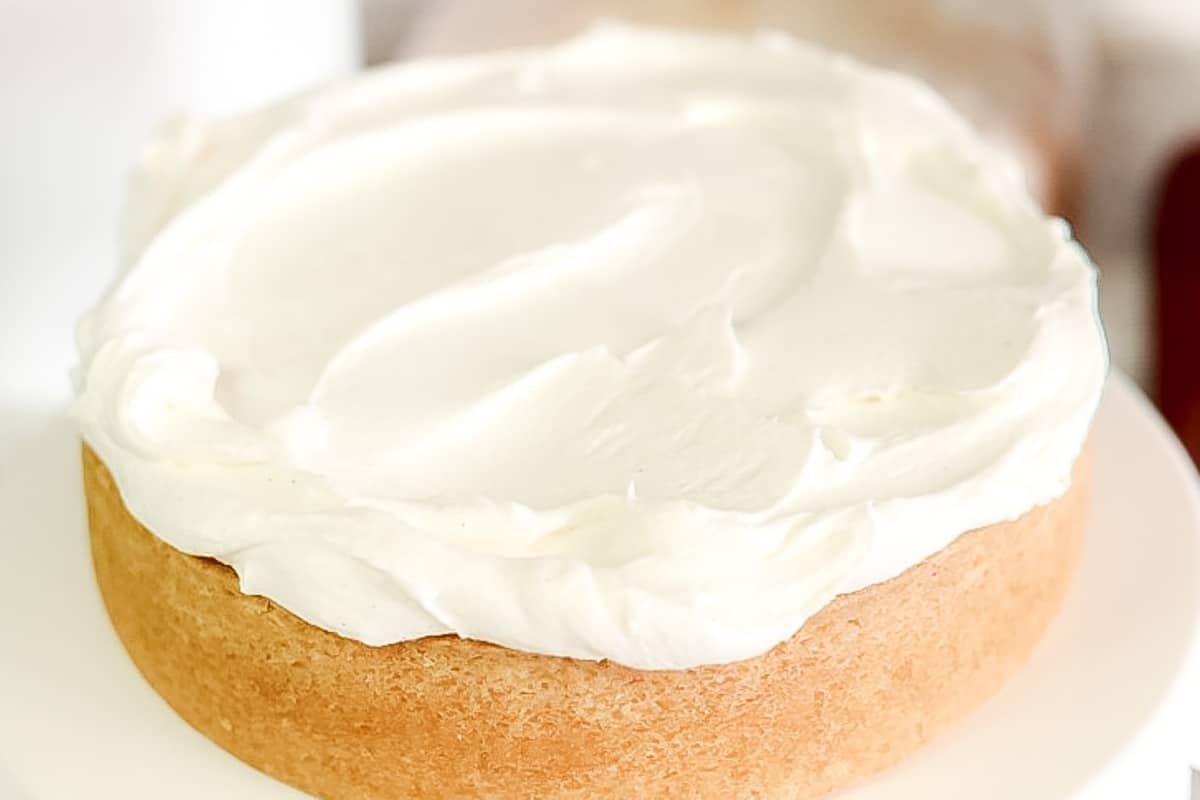
Next, add the second layer and cover the entire cake with buttercream.
You can find my buttercream recipe here: Vanilla Bean Buttercream
Tips & FAQs:
A white cake is usually whiter in color and could use vegetable shortening instead of butter to help get a lighter color cake. The vanilla is also isn’t usually as strong in a white cake as it would be in a vanilla cake.
A vanilla cake usually includes vanilla extract and a vanilla bean cake usually includes vanilla bean paste. Vanilla bean cake usually has a stronger vanilla flavor.
Vanilla bean paste is thicker and uses actual vanilla seeds. Using vanilla bean paste in cakes really pumps up the vanilla flavor.
Here’s a good article from Nielsen-Massey on when to use vanilla bean paste or vanilla extract: When to use Vanilla Bean Paste and Vanilla Extract
You can sometimes get it at craft stores that sell cake decorating supplies, but I generally order mine from Amazon.
Here are some options:
LorAnn Organic Madagascar Vanilla Bean Paste
Native Vanilla Bean Paste
Heilala Vanilla Bean Paste for Baking
Nielsen-Massey Pure Vanilla Bean Paste
Taylor & Colledge Organic Vanilla Bean Paste
Yes you sure can. I think using a good vanilla bean emulsion or paste really pumps up the flavor and can set your cake apart from the rest, but a real vanilla extract will work as well.
Cake flour is different than all-purpose flour and they can’t be substituted for each other in equal amounts. Cake flour will give your cake a more tender texture, so it’s best to use that in this recipe if you can get it.
If you can’t get cake flour, you’ll have to substitute it with all-purpose flour, but you’ll need to make these changes: For every cup of cake flour called for in the recipe, use one cup of all-purpose flour instead and remove two tablespoons of it, then replace that with two tablespoons of cornstarch.
Be careful not to pack the flour down into the measuring cup when you measure it out. That can add too much flour to the batter and cause the cake to be dense and dry. Just spoon the flour into the measuring cup and level it off.
Unsalted butter works best because you can estimate the proper amount of salt that will be added plus salted butter has a different water content than unsalted.
However, if you’re unable to get unsalted butter, you can use salted in the cake and the buttercream, but omit the additional salt that each recipe calls for.
Sour cream is best in this recipe as it helps make a very moist cake and gives a little flavor. If you don’t have access to it, you can use plain yogurt, but use the full-fat yogurt instead of the low-fat or fat-free type.
No, you don’t have to use it, but it’s really a very small amount and it just gives a hint of added flavor. Personally, I think it adds that extra secret ingredient that people just love and it doesn’t actually taste like almonds.
To see an even deeper discussion on why I really like a touch of it in this cake, check out the ingredient section closer to the top of this post.
The mixing method for this cake is called the reverse creaming method because instead of creaming the butter with the sugar, you’ll add the butter, in chunks, to the dry mixture which will coat it.
This method helps produce a softer cake and helps reduce the chance of over-mixing which can over-develop the gluten.
This cake is done baking when a toothpick inserted into the center of each layer comes out with a few moist crumbs on it or clean, but no raw batter.
This cake can be made ahead of time and frozen if desired. Let the baked cake cool completely, then wrap in plastic wrap and foil and place in the freezer for up to a month.
To thaw, place the wrapped cake on the counter at room temperature and let thaw completely, then remove the wrapping. Once defrosted, add the glaze.
This cake can be stored covered at room temperature for several days as long as it’s not covered or filled with a perishable frosting.
To prolong freshness, the cake can then be covered and stored in the refrigerator for a few additional days.
Most cakes are best served close to room temperature, especially when made with butter like this one. If the cake is cold, set it out to come closer to room temperature for about 20-30 minutes before serving.
You can also pop a slice in the microwave to warm up a bit.
Yes, but with a few changes. Fill 2 cupcake pans (24 cupcakes) with cupcake liners and fill with batter about ⅔ of the way full. Bake at 350 degrees F (do not turn the temperature down) and bake for about 15-25 minutes depending on the size of your oven. Start checking for doneness at around 12 minutes just to be sure.
You may have a bit of cake batter left over, but you can chill that batter and make the remaining cupcakes when the others have baked.
Yes, this cake works well for stacking as long as you use proper supports as you would stacking any cake.
As an Amazon Associate, I earn from qualifying purchases.
Supplies used for this recipe:
- Magic Line 8-inch round cake pans or Wilton 8-inch round cake pans
- Whisks
- Silicone spatula
- Mixing bowls
- Stand mixer or electric hand-mixer
- Cooling racks
- Vanilla bean paste options: LorAnn Organic Madagascar Vanilla Bean Paste, Native Vanilla Bean Paste, Heilala Vanilla Bean Paste for Baking, Nielsen-Massey Pure Vanilla Bean Paste, Taylor & Colledge Organic Vanilla Bean Paste, Almond emulsion
- Almond baking emulsion
Video:
Note About Recipe Measurements: I write recipes using volume (cups) measurements because here in the U.S., this is what people are more familiar with and I don’t want anyone to feel intimidated when baking. For metric/weight measurements, click the ‘metric’ button under the ingredients in the recipe card below. The weights are converted by a program, not me, and it’s just a best guess. I can’t guarantee that weighing the ingredients will produce the exact same results, since I test recipes using volume measurements.
Recipe
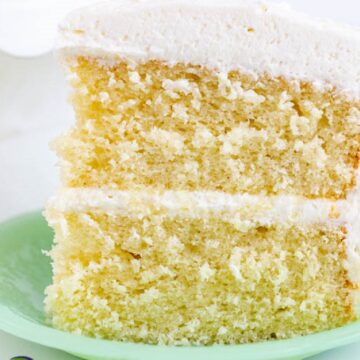
Favorite Vanilla Bean Cake
Ingredients
- 3 cups cake flour (not all-purpose flour, see FAQs in the post for substitutions)
- 2 cups granulated sugar
- 1 ½ teaspoon baking powder
- ½ teaspoon baking soda
- 1 teaspoon salt
- 1 cup unsalted butter, only slightly cooler than room temperature (2 sticks)
- 1 cup sour cream
- ½ cup whole milk
- 1 tablespoon vegetable oil
- 1 tablespoon vanilla bean paste (or vanilla extract)
- ½ teaspoon almond emulsion (optional)
- 3 large eggs
- Vanilla Bean Buttercream (recipe link in the notes section)
Instructions
- Preheat the oven to 350 degrees F. (You will turn the oven temperature down to 325 degrees F once you put the cakes in the oven.)
- Grease and flour two 8" round cake pans. (If making cupcakes, read notes below)
- Combine the flour, sugar, baking powder, baking soda and salt in a large mixing bowl and whisk well. Set aside.
- In another bowl, combine the sour cream, milk, oil, vanilla bean paste, almond extract and eggs. Mix well with a whisk and set aside.
- Cut the almost room-temperature butter into chunks. Turn the mixer on low and slowly add the butter, a bit at a time, to the dry ingredients. Once all the butter has been added, mix on medium to medium-high until all the flour is coated with the butter and the mixture is crumbly. It should have a sand-like texture. If the butter is too warm or if it's mixed for too long, it will form a paste and this will not produce a good cake texture.
- Pour about a third of the liquid mixture. into the dry mixture and mix on low to medium until well combined…about 30 seconds to one minute. (Some reverse creaming recipes call for mixing 1-2 minutes at this stage, but be careful about mixing longer than a minute as mixing for too long will cause a dense cake.)
- Pour the last of the liquid mixture into the dry mixture and mix again until well combined. Don't overmix the batter at this point. Stop mixing once everything is well incorporated, usually no more than about 20-30 seconds.
- Use a silicone spatula to scrape down the sides and bottom of the bowl. Mix again for only about 10 to 15 seconds.
- Pour the cake batter into the prepared pans.
- Slide the cake pans into the oven and turn the oven temp down to 325 degrees F (unless you're making these as cupcakes, in which case you'll want to read the notes below).
- Bake at 325 degrees F for approximately 40-45 minutes. The cakes are done when a toothpick inserted into the center of each layer comes out with a few moist crumbs on it or clean, but no raw batter.
- Set on wire racks to cool for ten minutes, then turn the cakes out onto the racks and let them cool out of the pans completely before adding buttercream frosting.
Notes
Nutrition
How to Share
I’d love for you to share this recipe link or tag it, but please do not share screenshots or copy/paste the recipe to social media as the content and photographs are copyright protected and we (bloggers) work really hard on our content. Sharing the link, tagging us on socials and pinning it is super appreciated though!

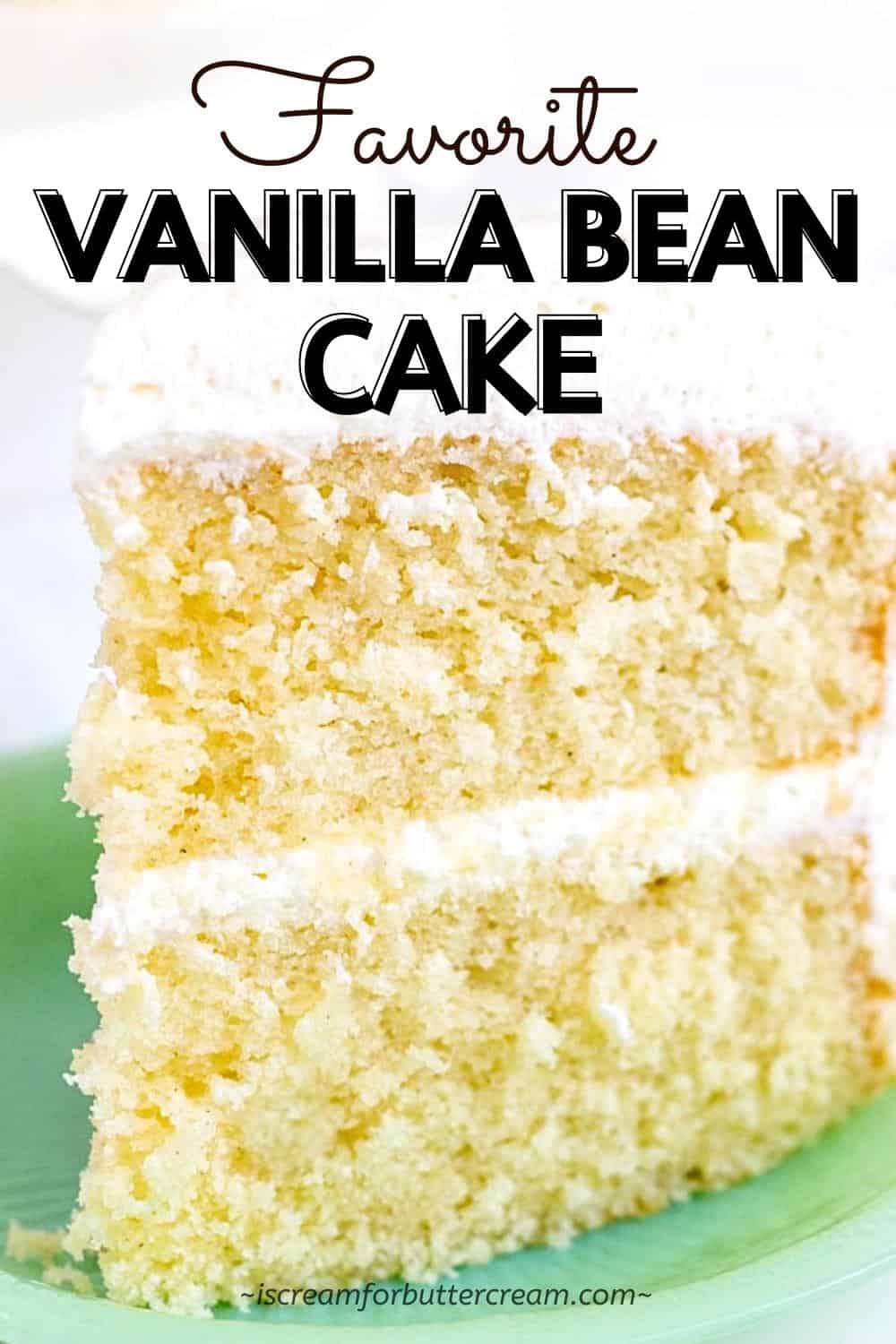
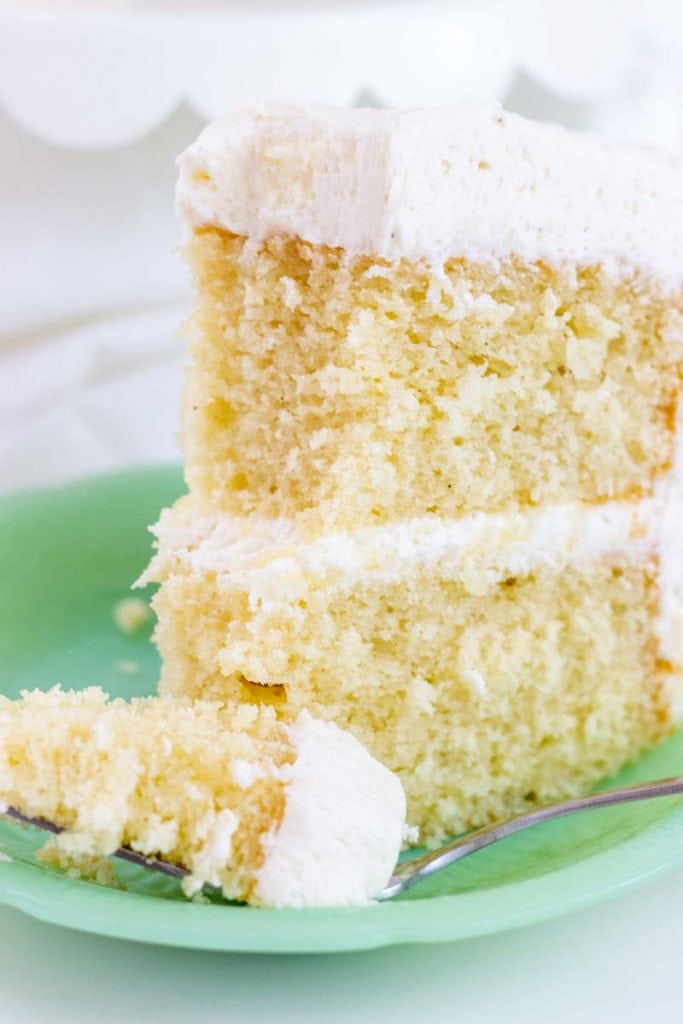
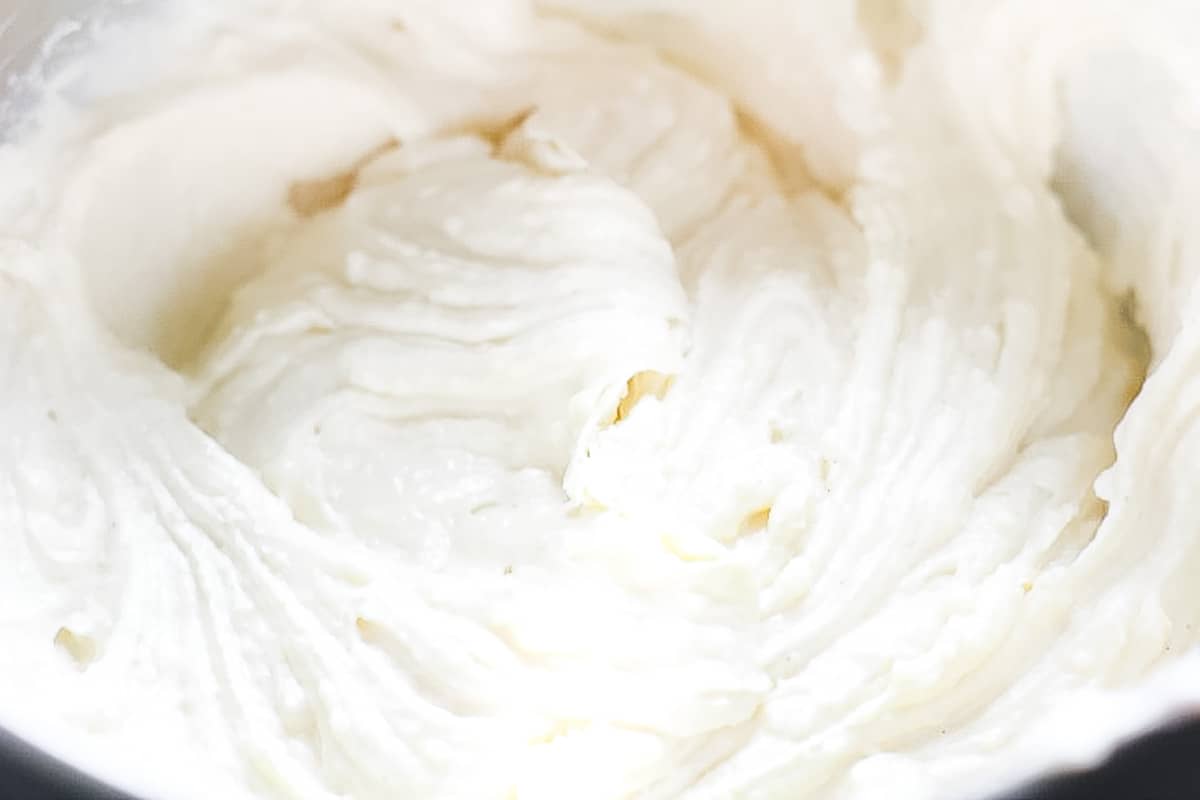
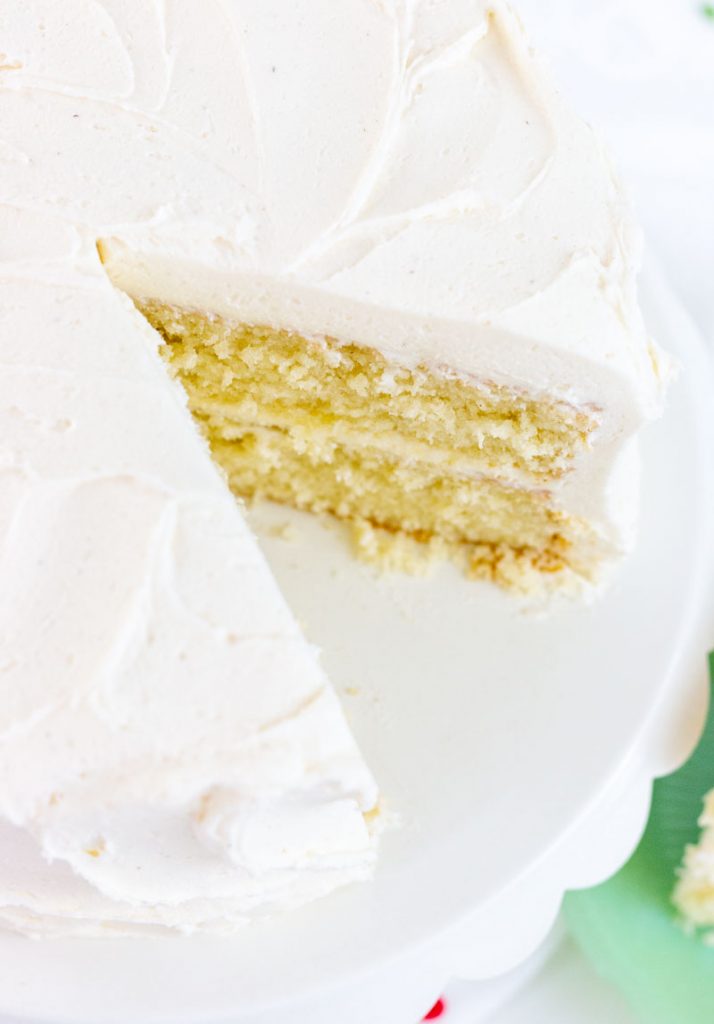

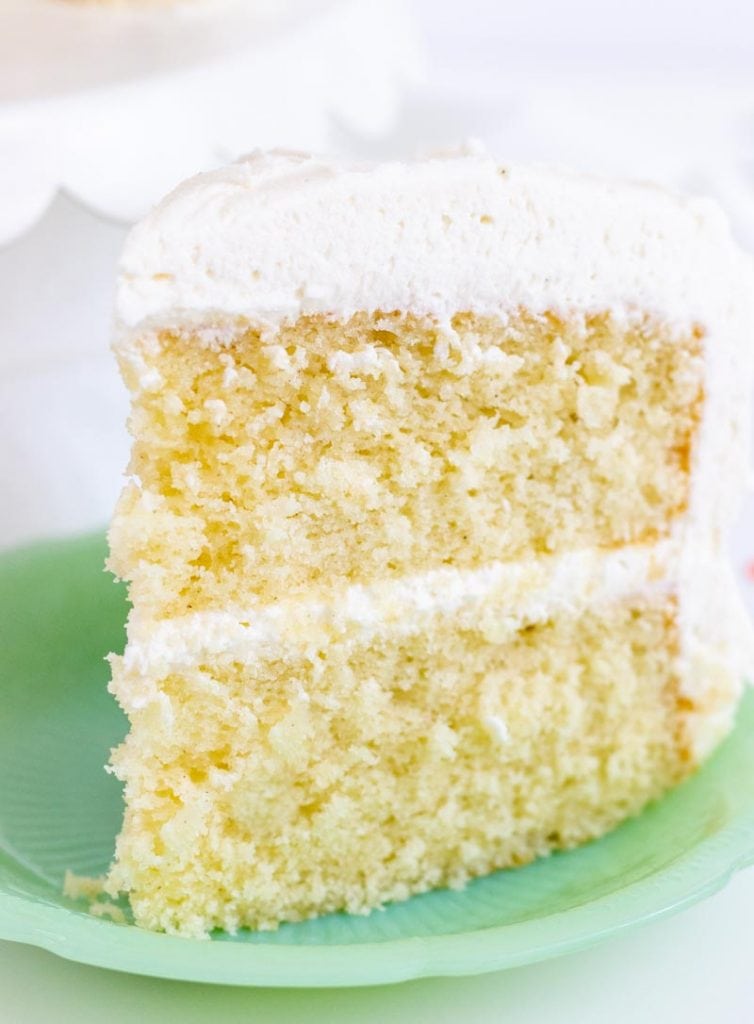
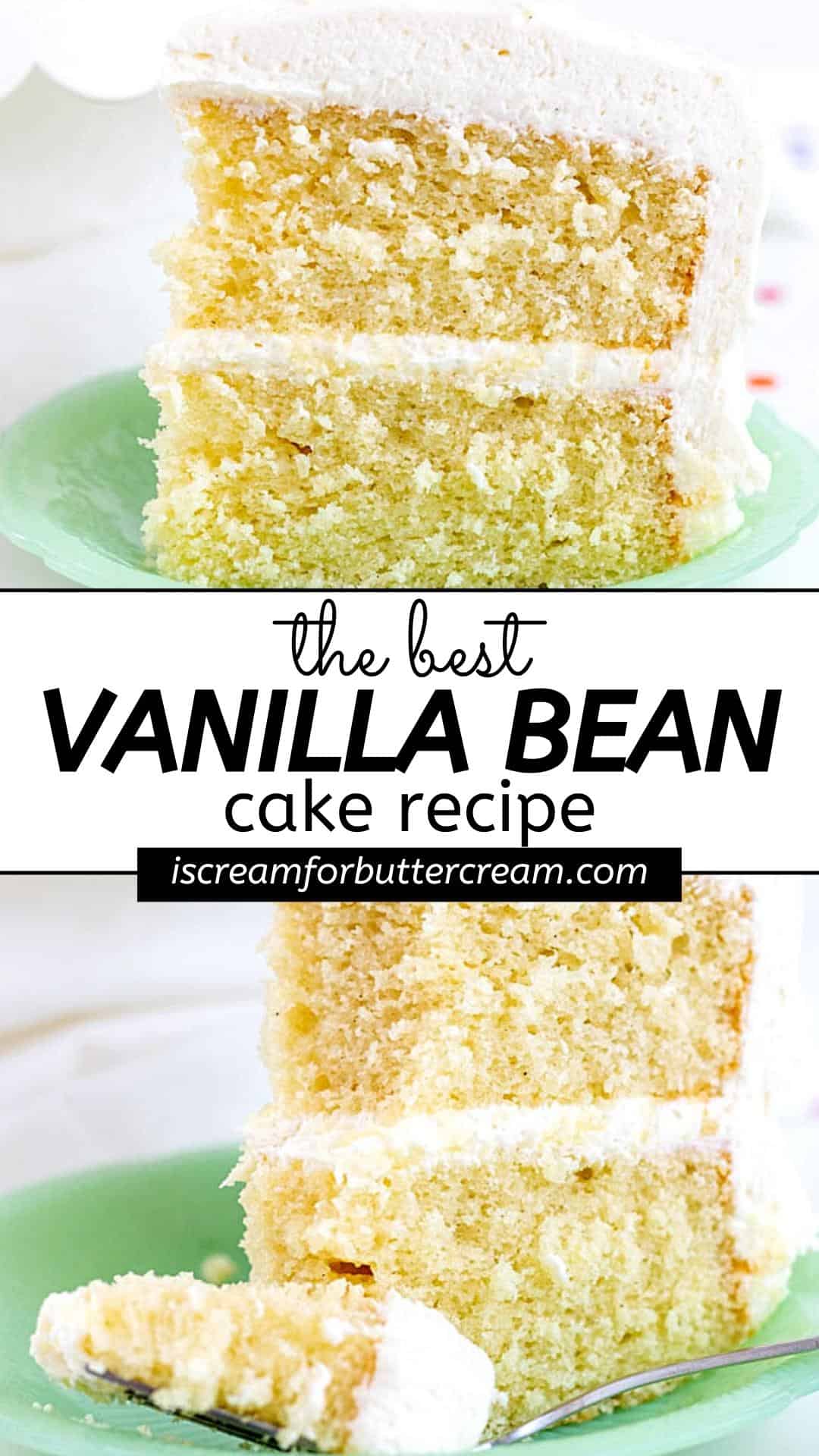
Ravi
Delicious!!! I have made this last night at my family party.
Kara Jane
Oh wonderful! I’m so glad you liked it! 🙂
Taylor
Hi Kara,
I only have one of each 6 and 8 inch pans. How would you recommend doing the oven at that point? Since you recommended turning the heat down.
Kara Jane
Hi there, You can use the 6″ and 8″ pans. You’ll probably have a bit of batter left over, since the recipe will fill two 8″ pans, but that’s perfectly okay. Keep the heat the same as the recipe calls for…it should be just fine. 🙂
Gina
Can I bake this recipe in a bundt pan? Thanks, Gina
Kara Jane
Yes you should be able to do that. I haven’t tried it that way, but I don’t see a reason it wouldn’t work. Just make sure to grease and flour your bundt pan very well. It’s a pretty moist and delicate cake, so it’ll stick easily. Watch your baking time…you might have to bake it for a little longer.
Amrit
Hi Kara,
Are you able to substitute the eggs for yoghurt maybe? I’ve subbed 1 egg for 1/4 cup yoghurt previously and wanted to know your thoughts on this?
Thanks
Kara Jane
I’ve heard of replacing the eggs with yogurt, but I’ve never actually tried it before. I’ll be honest though…I almost never have yogurt on hand. If you try it, I’d love to know how it turns out! I’m thinking the cake may turn out a bit dense though, but it’s worth experimenting I think.
Amrit
Hi Kara,
Tried out the Eggless version of this cake and I got to say it came out pretty well.
The taste was amazing.
Couple of things though, the top was cracked, and I probably needed more than 45 mins in the oven as it was slightly under done (don’t know if that was because of the yoghurt).
Also, could we slightly reduce the sugar as it was a little on the sweet side and didn’t have any icing on it?
Took a couple of pics of you were interested in having a look.
Great cake though!
Kara Jane
Thanks for the update! I was interested in how it would turn out. Yes, I’d like to see some pics. If you’d like to email them to me, you can send them to kara@iscreamforbuttercream.com
I think it should be okay to reduce the sugar a bit if you’d like. Generally I’d say no, but I think with the added yogurt etc., it might be okay. Just make sure not to reduce it too much, or it’ll affect the moistness and the texture. I’d try reducing by 1/2 a cup at first and see how that goes.
Glad it turned out well!
Bekah
Hi! Wondering how you think it would turn out if I used two 10 inch pans instead of the 8 inch?
Kara Jane
You could do that, but the layers would be thinner and it might need to bake for a less amount of time, since they batter won’t be as thick in the pans. What you could do is to add another 1/2 of the recipe when you mix it up, then you’ll get the proper amount of cake batter to fill the two 10 inch pans. So essentially, mix up a recipe and a half, then fill the two, 10 inch pans. Hope this helps!
Rebekah
Thank you so much for the advice!! Can’t wait to try it! 🙂
Kara Jane
You’re welcome! Let me know how you like it 🙂
Kristel Geake
Hi Kara Jane! I can’t wait to give this recipe a try. Unfortunately, I will have to leave out the almond emulsion for allergy purposes. I am, however, making this for my sons 5th birthday party and he has requested a ‘sprinkles’ or ‘funfetti’ cake. Is it possible to add 1/2 cup of rainbow jimmies to the batter without it affecting the overall texture and moisture? Any idea or tips? I really want to love this recipe as I have tried many white cake recipes which have all left me wanting to find another lol. Thanks for sharing!
Kristel
Kara Jane
Hi Kristel, I think adding in the rainbow jimmies will be just fine. I can’t think of any reason that it would change the texture, so I think you’re good to go on that. I WILL say though that this cake isn’t bright white, like some of the funfetti cakes are, because it’s got vanilla bean and whole eggs in it…that’s what makes it so good though. I’m actually working on a bright white version now, but it’s not yet ready to post. Anyway just be aware it’ll have a vanilla color to it (like the pics show), but it’s SO tasty. And no worries on omitting the almond emulsion, it’ll still taste good. We don’t want him to be allergic to his own birthday cake! Let me know how it all turns out! 🙂
Kristel Geake
Hi again Kara Jane! Just wanted to let you know I did a test run with the cake recipe without the jimmies (just to see how the cake itself would turn out on it’s own) and I’m writing to say ‘WOW’! I bake soooo much and this is the first vanilla cake recipe I have made that is amazing!! I omitted the almond as mentioned and the vanilla flavour still shined through. However, the texture of this cake is to die for… so tender and moist but not dense. This is THE vanilla cake recipe I have been searching my whole life for lol. Thank you so much again for sharing. I am definitely going to try your other cake recipes now. Absolute perfection! Wish me luck with the rainbow jimmies! 🙂
Kristel
Kara Jane
Oh yay!!! I’m so glad you liked it! 🙂 I really think the secret is the combination of sour cream and using cake flour. Really, I think sour cream makes everything better 😉 Good luck adding the rainbow jimmies…I think it will be just fine. Let me know how it all turns out!
Josepha Morgan
Are there other flavor variations for this recipe? Made 3 dozens of cupcakes last night and my husband and kids were eating them without the icing! This is by far the best recipe I’ve EVER tried!!!
Kara Jane
Oh I’m so glad you liked it! 🙂 I don’t really have any flavor variations for this one…that may be something I need to work on though! I do have a lemon cake recipe that’s loosely based on it. Here’s the link if you’d like to try it out: https://iscreamforbuttercream.com/lemon-sour-cream-cupcakes-lemon-buttercream/
Cheryl Evans
Hi Kara can I ask how you manage to make the butter cream icing so white , rather than a creamy colour?
It looks amazing on the cake
Kara Jane
Hi Cheryl, So, to get it more white, you can do a couple different things. You can add just a tiny bit of violet food coloring, which basically cancels out the yellow tint. You can also replace half of the butter in the buttercream recipe with vegetable shortening. If you want a really bright white, you can even replace all of the butter with vegetable shortening. I’ve actually got a post I’m working on that’ll be out soon on how to make bright white heat stable buttercream, but essentially you’re just using shortening instead of butter and then adding in a little extra flavoring. If you can get hi-ratio shortening, it makes for a really smooth and creamy white icing, but regular vegetable shortening works too. You’ll also want to add a pinch of salt because the shortening will make the icing seem sweeter. Hope this helps!
Cheryl Evans
Thank you …I am planning to make the cake today ….so will keep you posted
And thank you for such a speedy response.
Cheryl Evans
The vanilla bean butter cream I am referring to …
Cheryl Evans
Hi Kara I made this cake this weekend and followed your advice for the buttercream, using vegetable shortening…it was fabulous. The taste was lovely, and the cake so moist. I am converted…
Thank you so much for your advice
I can honestly say that we in Wales , UK loved the cake. I did send you a photo via email , so hope you received it.
Many thanks
Cher
Kara Jane
Oh wonderful Cheryl! So glad you it turned out well and that you liked it! And I’ll look for that email as well. 🙂
Kitty
Hi Kara Jane! I am making this cake for my boss’ birthday. I am using the actual vanilla beans and omitting the almond emulsion. Your recipe is exactly what I was looking for. She requested a vanilla only cake. I am doing a double layer 9″x13″ cake. Would I triple this recipe or would a double batch be enough? How many cups do you think would give me a nice size thickness?
Kara Jane
Hi Kitty, Using actual vanilla beans sounds amazing! So, on to your question. Are you planning to bake 2, 13 x 9 cakes, or just one and then splitting it into two parts? One recipe will be enough for a 9×13″ pan. Depending on how tall your pan is though, I probably would just bake one recipe in it though. Doubling the batter will likely cause an overflow (unless your pan is unusually tall). Once you get the first one baked, you can always bake another 13×9″ layer. Then you can just layer the two. That way you’re not having to slice one 13×9″ cake into two perfect layers (which always causes headaches for larger rectangle cakes). Hope that made sense!
Kitty
Thank you so much for your quick response Kara! I just love that you respond to everyone. Yes, I am making 2, 13×9″ cakes. I’m wondering if 1 whole vanilla bean would be enough for each cake. I want a rich vanilla flavor with the “dirt” in it as one mother said.
Kara Jane
Oh, yes and that ‘dirt’ makes it SO good! lol! I did a quick google search and google says that one teaspoon of extract is equivalent to one inch of vanilla bean. The cake recipe calls for 1 Tbsp and since there’s three teaspoons in a tablespoon, that would be three inches of vanilla bean. That’s a lot and it would probably be okay to just use two inches if you wanted for each recipe. I hope this helps and do let me know how it turns out…I’m interested!
Marija
Hi there, i’m making a two tier cake for my sisters confirmation and was planing on using a 10in for the bottom and an 8 in for the top. I was just wondering how to adjust the recipe to make two 10in cakes? Thank you in advance!!
Kara Jane
Hi there, for the 10″ pans, I would make a recipe and a half of the batter to fill 2, 10″ pans. Hope this helps!
Barb N
So this is an amazing recipe, the flavor and tenderness are to die for. But for the life of me I cannot get my cake to bake without rather large holes. Have you ever experienced this? I’m an experienced baker working with a commercial oven and I can’t figure out why every batch has holes! I’m timing my mixing so I don’t think it’s over mixing. Any advice would be appreciated!
Kara Jane
Hi Barb, Hmmm…I haven’t had trouble with holes in this one, but I have a couple suggestions. The first one is…and you knew I would say this…try mixing just a bit less than you’re mixing. If you’re positive you’re not mixing too long, the other option is to try mixing at a lower speed. Something else to try…once you’ve poured your cake in your pans, try lightly dropping them on your counter a few times, so any air bubbles come up to the surface, then place them in the oven. You could also try sifting the dry ingredients. Sometimes that can help. Last, if nothing else will help, you might lower the leavener just a tad. I’d lower the baking soda by 1/4 tsp and see if that makes a difference.
I’m so glad you liked the cake and hopefully one of these tips will help with the air bubbles!
Vicki
I made a half recipe of your cake yesterday – it turned out great. I made it in a 8 in round 3 in deep pan and filled the pan about a little over half. It was about 1 in from the top. I am making a 10, 8, 6 in wedding cake this weekend (all 3″ deep) and would also like to make one 12×18 sheet cake. CAN YOU TELL ME HOW MANY RECIPES I WOULD NEED AND ALSO HOW HIGH TO FILL THE PANS? Thank you so much – we loved the cake…I just need it to rise to the top vs an inch from the top.
Kara Jane
Hi Vicki, I normally use 2″ tall pans, so if you’re using 2, 3″ tall, 8″ round pans, I would make a recipe and a half. That should be plenty to fill the pans 2/3 of the way up. Ok, now onto the other sizes… and wow, you’re going to be making a lot of cake and I am SO coming to this wedding. Lol! Ok, I’m going to make some estimates here for the other pans, but just know when filling the pans, you’ll need to fill them about 2/3 of the way up. And for clarity’s sake, this is for 3″ tall pans and not the 2″ pans. For the 6″ round pans, one recipe should do it. We talked about the 8″ round pans above. For the 10″ round pans, I’d go for 2 to 2 1/2 recipes. For the 12 x 18 sheet cake, I’d maybe make two recipes just to be safe, but you may have a little batter left over. Okay, so these are all estimates…I’m not used to baking in 3″ tall pans, so just keep that in mind. 😉 Oh and hey, this cake freezes well and since you’re making so much, it might be helpful for you to freeze a couple of them ahead of time. Here’s a link to my freezing cakes post. It’ll go through how I freeze them without any freezer burn, why I think it actually makes cakes more moist to freeze them and how to properly defrost them so you don’t get too much condensation all over the cake layers. https://iscreamforbuttercream.com/freezing-cakes-and-cupcakes/
I hope this helps and let me know how it all goes!
Vicki
Thanks so much for getting back to me. I should have told you the 12×18 sheets are only 2″ tall (not 3) The rounds are all 3″. Do you think then that 1 and 1/2 recipes would be good for those?
Kara Jane
Hmmm…well one recipe would make a 13×9 inch pan, so 1 1/2 might do the trick. Use your best judgement on that one. If you do two recipes and have leftever batter, you could just make some cupcakes out of it and then keep those for yourself. 😉
Lauren
Do you sift then measure your cake flour for this particular recipe? I find that whenever I use cake flour in a recipe, it always needs to be sifted. But there’s often lots of variation between whether or not to sift before or after measuring in recipes, and also the number of times it needs to be sifted — cakes especially. Would greatly appreciate your method of prep on that particular step because I know how much it can impact the final product! Thanks bunches.
Kara Jane
Hi Lauren, Those are good questions. I have to admit that I usually don’t sift. Not because of any huge reason or anything…it’s mainly just for simplicity sake. You can certainly sift if you’d like to as it definitely couldn’t hurt anything. For the recipes on my site, I would sift after measuring though.